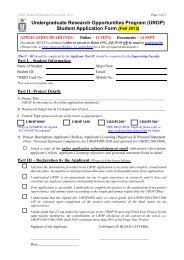UROP Proceedings 2010-11
UROP Proceedings 2010-11
UROP Proceedings 2010-11
You also want an ePaper? Increase the reach of your titles
YUMPU automatically turns print PDFs into web optimized ePapers that Google loves.
Capture the FlagAdvisor : SHI Ling / ECEStudents : CAI Hong / ELEC-HR(<strong>UROP</strong>1000, Summer 20<strong>11</strong>)LU Yongxi / ELEC-HR(<strong>UROP</strong>1000, Summer 20<strong>11</strong>)TU Jia / CPEG-HR(<strong>UROP</strong>1000, Summer 20<strong>11</strong>)WANG Yongduo / ELEC(<strong>UROP</strong>1000, Summer 20<strong>11</strong>)“Capture the flag” is a game that involves the interaction between semi-autonomous mobilerobots and human players. Under certain rules, a number of mobile robots are divided intotwo teams and they compete against their opponents to capture a virtual flag of the other team.The robots are remotely controlled by human players, and the players are provided withgraphical user interface (GUI) which informs them of the current location of their robot on thegame field to facilitate manipulation. In this project, the game consists of several essentialmodules, which are the controller module, the AI module, the server module and the clientmodule. A set of game rules is determined, and the technical modules will be tested based onthe rules.Mobility Pattern Tracking Using GPS, Wi-Fi and Cell IDAdvisorCo-AdvisorStudent: WONG Albert K S / ECE: WOO Kam Tim / ECE: WANG Xiaoli / ELEC-HR(<strong>UROP</strong>1000, Summer 20<strong>11</strong>)Tracking the mobility pattern of children and elderly is a potentially useful application, as itprovides a way for parents and care givers to know location of the children and elderly undertheir care. Assisted GPS (AGPS) and Wi-Fi can be used to precisely calculate the location, butit consumers a lot of energy. On the other hand, Cell ID and WiFi signal can allow thedetermination of location with much less energy and at a lower cost. This project is anexperiment on an energy-efficient cellular and AGPS/Cellular/Wi-Fi tracking algorithm basedon the knowledge of a person’s mobility history. The algorithm makes use of the concept ofcrucial location (CL) and personal common location (PCL) to construct a person’s mobilitymap, where CL is a point where multiple paths intersect and PCL is the area where a userspend most of his/her time. AGPS location fixes are scheduled based on a person’s predictedmovement along this mobility map. A conference paper has been submitted based on thiswork.51



